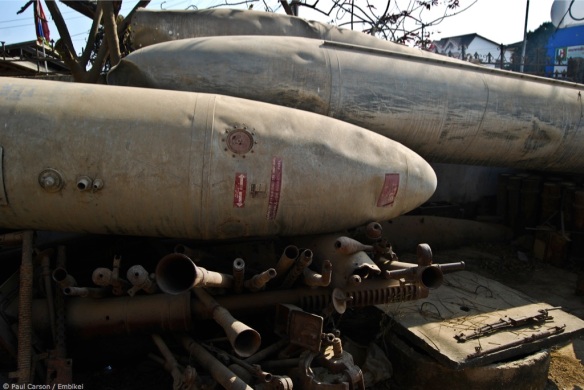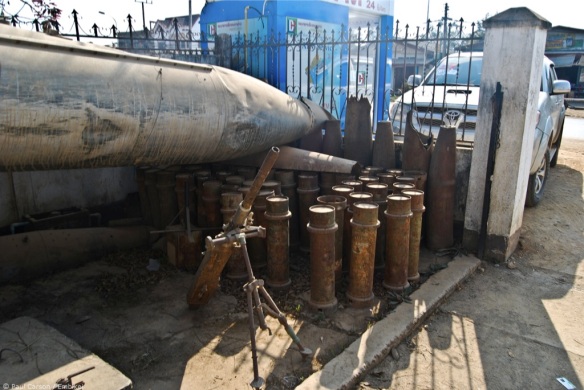PHONSAVAN, LAOS – Not many people would’ve heard of this town. And surprisingly few would know that this province in central Laos holds the tragic distinction of being the most heavily bombed part of the world, per capita, in history. This small mountainous area holds many secrets that the United States was actively involved in, and the results of those secrets remain buried today, and still continue to kill.

A path marker placed by the Mines Advisory group. These are used to make a path along an area that has been “demined”, or cleared of UXO.
In the mid-1960s until 1975, the United States ran a secret war in Laos, overseen by the CIA and fought by “sheep-dipped” military personnel who flew their combat missions out of uniform. The ground troops (and even a fair portion of the air force) were made up of local Hmong tribespeople. The enemy was the Pathet Lao, a revolutionary Communist military force backed by Ho Chi Minh and the North Vietnamese Army. This action was part of Ho Chi Minh’s dream to create a fully Communist Indochina comprising of Vietnam, Laos, and Cambodia.
The North Vietnamese ran a supply line down into South Vietnam, the famous Ho Chi Minh Trail. It was the existence of this trail that the US used to justify the saturation bombing ofthe areas of Laos and Cambodia (two countries that had nothing to do with the conflict) that bordered Vietnam. Once the NVA began pushing west into Laos, the United States stepped up it’s presence to defend the country against Communism.
Officially, there were no US combat personnel stationed in Laos. The reality was quite different. Operating out of an airfield in the town of Long Tieng, the CIA and the United States Air Force guided fighters and bombers stationed in Thailand in strike missions against Vietnamese supply vehicles on the Ho Chi Minh Trail in southern Laos. They also targetted NVA and Pathet Lao forces engaged in combat against the Lao Royal Army from near Phonsavan to the Vietnamese border.
As the Pathet Lao and the NVA began taking more ground, the USAF began dropping more explosives. Many of these bombs were not very accurate, often straying miles from target and landing on civilian villages. Some of these weapons were cluster bombs, designed to spread it’s lethal payload over a very wide area.

Empty bomb casings on display at the Phonsavan Tourist Information Centre
After nine years of bombing, at least 1.3 million tons of ordnance was dropped on Laos. Around a third of these bombs failed to detonate on impact.
Unfortunately, the deadly legacy continues even now. Many farmers and villagers have been killed by either stumbling across these unstable devices or trying to remove them once they’d been discovered. Because a lot of UXO is buried, some farmers are very reluctant to cultivate their own land for fear of being killed.
The Mines Advisory Group, a UK-based NGO with branches throughout the world, set up a presence in Phonsavan in 1994 and has been working wth local people ever since to make their land safe again. Working with UXO Lao, MAG has been training local people in all aspects of mine and UXO clearance. Given the amount of unexploded ordnance still lying around Laos, and Xieng Khoung province in particuar, this mission will probably take a long time to complete.

